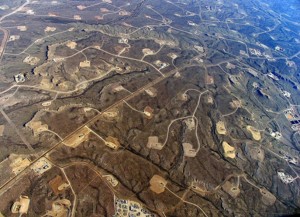The End of the Fracking Ponzi is Nigh
The US Federal Reserve’s Free Money policies [Zero Interest Rate Policy (“ZIRP”) and Quantitative Easing (“QE”)] have favoured the provision of debt to the shale oil industry. This is one of many areas of resource misallocation within the US economy and it may be the catalyst for economy-wide disaster.
The fracking industry, producing oil and gas from “tight” shale, has serious problems in three areas: financial, technical and environmental. I shall discuss each of these area in brief below.
Financial
The shale oil sector could not show a profit with oil above USD100/bbl. Imagine the carnage now that the price is hovering near USD70/bbl.
The business has been financed by ever more debt from Wall Street. This issuance of junk bonds and the like is coming to an end.
Meanwhile, creative accounting is helping to keep cash in the till. Companies are selling leases and infrastructure and seeking to “restructure” royalty payments.
The oil majors such as Royal Dutch Shell and British Petroleum are leaving the building due to lack of profitability.
Technical
The shale oil resource base is shrinking by the month. In May the US Energy Information Administration (“EIA”) dramatically cut the reserves of California’s Monterey Shale. It was once thought to contain around 13.7 billion barrels of recoverable oil. Now it is thought that only around 600 million barrels could be extracted. A 96% reduction.
The reserves of other shale basins prospective for, or producing oil, have also been cut. And it appears that the best spots have already been drilled in many basins.
A typical fracked shale oil well has a very short life. Production often declines by as much as 60% in the first year. In comparison, conventional wells will typically last for decades.
Fracking companies are on a treadmill, they have to keep drilling to maintain production. And, preferably, attempting to grow production to impress financiers, while unit costs continue to rise.
Infrastructure is poor for many basins, consequently any gas associated with oil is just flared off. Much oil is transported across the US by train. This is expensive and rather dangerous. A number of trains have already caught fire. A tragedy is awaiting.
Finally, the oil is often of rather poor quality and cannot be used for higher octane fuels, used by most vehicles today.
Environment
Fracking ruins the neighbourhood, as the image below shows. Not something anyone would want in their backyard.
Fracking uses vast quantities of water, along with a huge number of chemicals, each with specific tasks. For example, viscosity modifiers, clay stabilisers, biocides, corrosion inhibitors, etc. Some of these chemical are toxic.
A company in California was found to be disposing of fracking fluid by pumping it into an aquifer used for drinking water. Unbelievable.
Conclusion
The fracking industry in the US is on a very short fuse. It doesn’t turn a profit and peak production will arrive within the next few years. It will be interesting to see the fate of the mountains of debt that have financed the industry.
It is a perilous place to invest and is highly unlikely to prove economical current oil prices anywhere in the world.

